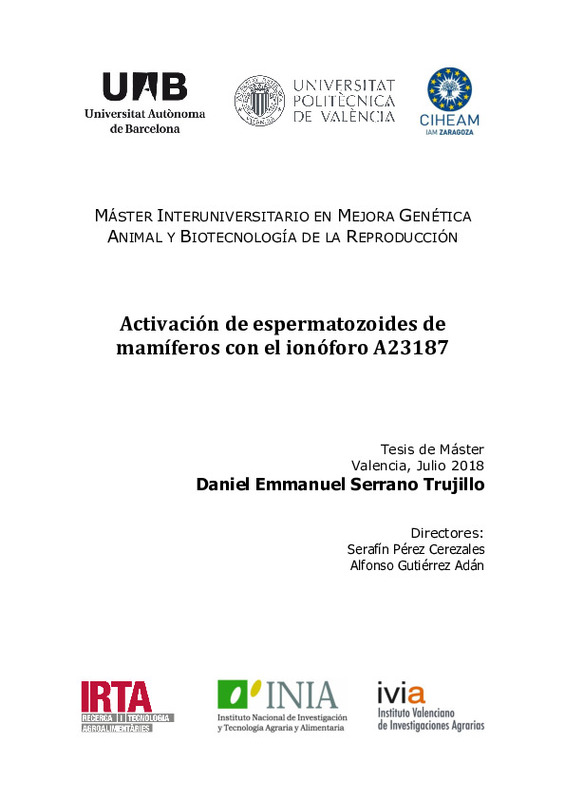|
Resumen:
|
Los espermatozoides de mamíferos adquieren la capacidad fecundante en el tracto femenino en un proceso llamado capacitación. Sin embargo de los millones de espermatozoides que se producen y eyaculan solo una fracción muy ...[+]
Los espermatozoides de mamíferos adquieren la capacidad fecundante en el tracto femenino en un proceso llamado capacitación. Sin embargo de los millones de espermatozoides que se producen y eyaculan solo una fracción muy pequeña, estimada en torno al 10%, adquiere este estadio capacitado en un momento dado. Nuestra hipótesis es que es posible activar otras subpoblaciones no capacitadas para que adquieran la habilidad de fecundar mediante la inducción de procesos relacionados con la capacitación. A nivel molecular, uno de estos procesos es el aumento del calcio intracelular. Por esta razón, los ionóforos de Ca2+, como el A23187, son comúnmente usados como inductores de capacitación espermática al provocar la entrada de calcio al citoplasma del espermatozoide y producir cambios equiparables a la capacitación, como por ejemplo la inducción de un tipo de motilidad vigoroso conocido como hiperactivación. El objetivo del presente trabajo fue conseguir la activación de poblaciones espermáticas no capacitadas mediante la utilización del ionóforo de Ca2+ A23187 (a partir de ahora solo se denominará como ionóforo) tanto en ratón como en toro. En espermatozoides de ratón observamos que el tratamiento con concentraciones de 5 y 10 µM de ionóforo provocó hiperactivación e inducción de la reacción acrosómica a un mismo nivel alcanzando saturación en ambas respuestas. Además, utilizando una concentración subóptima de espermatozoides para realizar la fecundación in vitro, el tratamiento con 5 µM de ionóforo aumentó la tasa de fecundación de un 49% obtenida en el control a un 68% (P<0,05 de acuerdo con ANOVA). Sin embargo el tratamiento con 10 µM provocó un ligero descenso en la tasa de fecundación con respecto al control indicando cierto nivel de toxicidad a esta concentración. En espermatozoides de toro observamos una tasa de reacción acrosómica elevada en la muestra control (76%). Esto se debió a que utilizamos muestras criopreservadas y el mismo proceso de congelación/descongelación induce la reacción acrosómica. El tratamiento con ionóforo no aumento esta tasa de reacción acrosómica posiblemente porque todos los espermatozoides susceptibles ya estaban reaccionados por el propio proceso de congelación/descongelación. Tampoco encontramos efecto alguno del tratamiento con ionóforo sobre la capacidad fecundante de estos espermatozoides de toro. Los resultados indican que en ratón existe una subpoblación sensible a la activación por el ionóforo que se hiperactiva, pierde su acrosoma y es capaz de fecundar en condiciones in vitro. Sin embargo en toro pensamos que el proceso de criopreservación seminal ya ha activado esta subpoblación haciéndola insensible al ionóforo.
[-]
Mammalian spermatozoa acquire the fertilizing capacity in the female tract in a process called capacitation. However, of the millions of spermatozoa that are produced and ejaculate only a very small fraction, estimated at ...[+]
Mammalian spermatozoa acquire the fertilizing capacity in the female tract in a process called capacitation. However, of the millions of spermatozoa that are produced and ejaculate only a very small fraction, estimated at around 10%, acquires this capacitation stage at a given time. Our hypothesis is that it is possible to activate other subpopulations not activated to acquire the ability to fertilize by inducing processes related to capacitation. At the molecular level, one of these processes is the increase in intracellular calcium. For this reason, Ca2+ ionophores, such as A23187, are commonly used as inducers of sperm capacitation by causing the entry of calcium into the cytoplasm of the spermatozoa and produce changes comparable to capacitation, such as the induction of a vigorous motility type known as hyperactivation. The aim of the present work was to achieve the activation of non-capacitated sperm subpopulations through the use of the Ca2+ ionophore A23187 (referred to hereafter as ionophore) in both mouse and bull. In mouse spermatozoa we observed that the treatment with concentrations of 5 and 10 ¿M of ionophore caused hyperactivation and induction of the acrosome reaction at the same level, reaching saturation in both responses. In addition, using a suboptimal concentration of spermatozoa to perform in vitro fertilization, treatment with 5 ¿M of ionophore increased the fertilization rate from 49% obtained in the control to 68% (P <0.05 according to ANOVA) . However, treatment with 10 ¿M caused a slight decrease in the fertilization rate with respect to the control indicating a certain level of toxicity at this concentration. In bull spermatozoa we observed a high level of acrosome reaction in the control sample (76%). This was possibly due to the fact that we use cryopreserved samples and the freezing/thawing process could have induce the acrosome reaction by itself. The ionophore treatment did not increase this rate of acrosome reaction possibly because all the susceptible spermatozoa were already reacted by the freezing/thawing process itself. Nor did we find any effect of the ionophore treatment on the fertilizing capacity of these bull spermatozoa. The results indicate that in the mouse there is a subpopulation sensitive to activation by the ionophore that becomes hyperactive, loses its acrosome and is able to fertilize under in vitro conditions. However in bull we think that the process of sperm cryopreservation has already activated this subpopulation making it insensitive to the ionophore.
[-]
|







